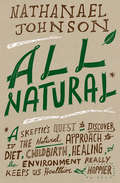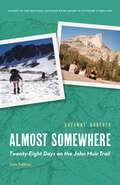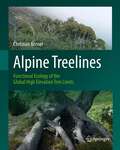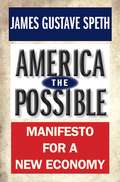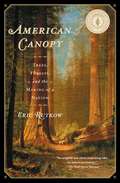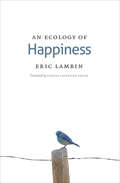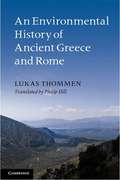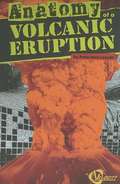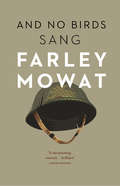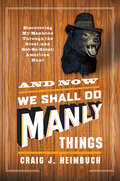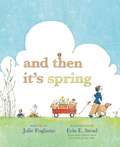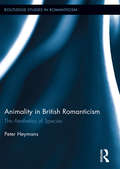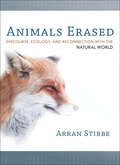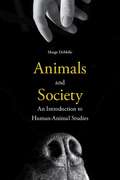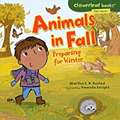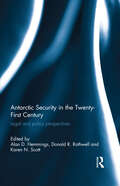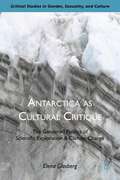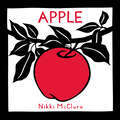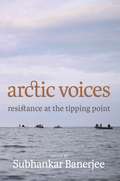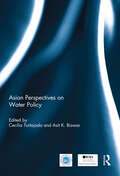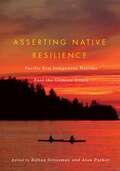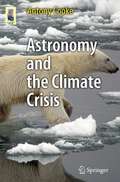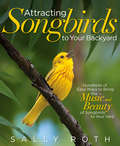- Table View
- List View
All Natural*: *A Skeptic's Quest to Discover If the Natural Approach to Diet, Childbirth, Heal ing, and the Environment Really Keeps Us Healthier and Happier
by Nathanael JohnsonIn this age of climate change, killer germs, and obesity, it's easy to feel as if we've fallen out of synch with the global ecosystem. This ecological anxiety has polarized a new generation of Americans: many are drawn to natural solutions and organic lifestyles, while others rally around high-tech development and industrial efficiencies. Johnson argues that both views, when taken to extremes, can be harmful, even deadly.Johnson, raised in the crunchy-granola epicenter of Nevada City, California, lovingly and rigorously scrutinizes his family's all-natural mindset, a quest that brings him into the worlds of an outlaw midwife, radical doctors, renegade farmers and one hermit forester. Along the way, he uncovers paradoxes at the heart of our ecological condition: Why, even as medicine improves, are we becoming less healthy? Why are more American women dying in childbirth? Why do we grow fatter the more we diet? Why have so many attempts to save the environment backfired?In All Natural*--a sparklingly intelligent, wry, and scrupulously reported narrative--Johnson teases fact from faith and offers a rousing and original vision for a middle ground between natural and technological solutions that will assuage frustrated environmentalists, perplexed parents, and confused consumers alike.
Almost Somewhere: Twenty-Eight Days on the John Muir Trail (Outdoor Lives)
by Suzanne RobertsWinner of the National Outdoor Book Award in Outdoor Literature It was 1993, Suzanne Roberts had just finished college, and when her friend suggested they hike California&’s John Muir Trail, the adventure sounded like the perfect distraction from a difficult home life and thoughts about the future. But she never imagined that the twenty-eight-day hike would change her life. Part memoir, part nature writing, part travelogue, Almost Somewhere is Roberts&’s account of that hike. John Muir wrote of the Sierra Nevada as a &“vast range of light,&” and that was exactly what Roberts was looking for. But traveling with two girlfriends, one experienced and unflappable and the other inexperienced and bulimic, she quickly discovered that she needed a new frame of reference. Her story of a month in the backcountry—confronting bears, snowy passes, broken equipment, injuries, and strange men—is as much about finding a woman&’s way into outdoor experience as it is about the natural world Roberts so eloquently describes. Candid and funny, and finally, wise, Almost Somewhere not only tells the whimsical coming-of-age story of a young woman ill-prepared for a month in the mountains but also reflects a distinctly feminine view of nature. This new edition includes an afterword by the author looking back on the ways both she and the John Muir Trail have changed over the past thirty years, as well as book club and classroom discussion questions and photographs from the trip.
Alpine Treelines: Functional Ecology of the Global High Elevation Tree Limits
by Susanna Riedl Christian KörnerAlpine treelines mark the low-temperature limit of tree growth and occur in mountains world-wide. Presenting a companion to his book Alpine Plant Life, Christian Körner provides a global synthesis of the treeline phenomenon from sub-arctic to equatorial latitudes and a functional explanation based on the biology of trees. The comprehensive text approaches the subject in a multi-disciplinary way by exploring forest patterns at the edge of tree life, tree morphology, anatomy, climatology and, based on this, modelling treeline position, describing reproduction and population processes, development, phenology, evolutionary aspects, as well as summarizing evidence on the physiology of carbon, water and nutrient relations, and stress physiology. It closes with an account on treelines in the past (palaeo-ecology) and a section on global change effects on treelines, now and in the future. With more than 100 illustrations, many of them in colour, the book shows alpine treelines from around the globe and offers a wealth of scientific information in the form of diagrams and tables.
America the Possible: Manifesto for a New Economy
by James Gustave SpethIn this third volume of his award-winning American Crisis series, James Gustave Speth makes his boldest and most ambitious contribution yet. He looks unsparingly at the sea of troubles in which the United States now finds itself, charts a course through the discouragement and despair commonly felt today, and envisions what he calls America the Possible, an attractive and plausible future that we can still realize. The book identifies a dozen features of the American political economy—the country's basic operating system—where transformative change is essential. It spells out the specific changes that are needed to move toward a new political economy—one in which the true priority is to sustain people and planet. Supported by a compelling "theory of change" that explains how system change can come to America, the book also presents a vision of political, social, and economic life in a renewed America. Speth envisions a future that will be well worth fighting for. In short, this is a book about the American future and the strong possibility that we yet have it in ourselves to use our freedom and our democracy in powerful ways to create something fine, a reborn America, for our children and grandchildren.
American Canopy: The Role of Trees in the Shaping of a Nation
by Eric RutkowThis fascinating and groundbreaking work tells the remarkable story of the relationship between Americans and their trees across the entire span of our nation's history. Like many of us, historians have long been guilty of taking trees for granted. Yet the history of trees in America is no less remarkable than the history of the United States itself--from the majestic white pines of New England, which were coveted by the British Crown for use as masts in navy warships, to the orange groves of California, which lured settlers west. In fact, without the country's vast forests and the hundreds of tree species they contained, there would have been no ships, docks, railroads, stockyards, wagons, barrels, furniture, newspapers, rifles, or firewood. No shingled villages or whaling vessels in New England. No New York City, Miami, or Chicago. No Johnny Appleseed, Paul Bunyan, or Daniel Boone. No Allied planes in World War I, and no suburban sprawl in the middle of the twentieth century. America--if indeed it existed--would be a very different place without its millions of acres of trees. As Eric Rutkow's brilliant, epic account shows, trees were essential to the early years of the republic and indivisible from the country's rise as both an empire and a civilization. Among American Canopy's many fascinating stories: the Liberty Trees, where colonists gathered to plot rebellion against the British; Henry David Thoreau's famous retreat into the woods; the creation of New York City's Central Park; the great fire of 1871 that killed a thousand people in the lumber town of Peshtigo, Wisconsin; the fevered attempts to save the American chestnut and the American elm from extinction; and the controversy over spotted owls and the old-growth forests they inhabited. Rutkow also explains how trees were of deep interest to such figures as George Washington, Thomas Jefferson, Benjamin Franklin, Teddy Roosevelt, and FDR, who oversaw the planting of more than three billion trees nationally in his time as president. As symbols of liberty, community, and civilization, trees are perhaps the loudest silent figures in our country's history. America started as a nation of people frightened of the deep, seemingly infinite woods; we then grew to rely on our forests for progress and profit; by the end of the twentieth century we came to understand that the globe's climate is dependent on the preservation of trees. Today, few people think about where timber comes from, but most of us share a sense that to destroy trees is to destroy part of ourselves and endanger the future. Never before has anyone treated our country's trees and forests as the subject of a broad historical study, and the result is an accessible, informative, and thoroughly entertaining read. Audacious in its four-hundred-year scope, authoritative in its detail, and elegant in its execution, American Canopy is perfect for history buffs and nature lovers alike and announces Eric Rutkow as a major new author of popular history.
American Canopy: Trees, Forests, and the Making of a Nation
by Eric RutkowThis fascinating and groundbreaking work tells the remarkable story of the relationship between Americans and their trees across the entire span of our nation's history. Like many of us, historians have long been guilty of taking trees for granted. Yet the history of trees in America is no less remarkable than the history of the United States itself--from the majestic white pines of New England, which were coveted by the British Crown for use as masts in navy warships, to the orange groves of California, which lured settlers west. In fact, without the country's vast forests and the hundreds of tree species they contained, there would have been no ships, docks, railroads, stockyards, wagons, barrels, furniture, newspapers, rifles, or firewood. No shingled villages or whaling vessels in New England. No New York City, Miami, or Chicago. No Johnny Appleseed, Paul Bunyan, or Daniel Boone. No Allied planes in World War I, and no suburban sprawl in the middle of the twentieth century. America--if indeed it existed--would be a very different place without its millions of acres of trees. As Eric Rutkow's brilliant, epic account shows, trees were essential to the early years of the republic and indivisible from the country's rise as both an empire and a civilization. Among American Canopy's many fascinating stories: the Liberty Trees, where colonists gathered to plot rebellion against the British; Henry David Thoreau's famous retreat into the woods; the creation of New York City's Central Park; the great fire of 1871 that killed a thousand people in the lumber town of Peshtigo, Wisconsin; the fevered attempts to save the American chestnut and the American elm from extinction; and the controversy over spotted owls and the old-growth forests they inhabited. Rutkow also explains how trees were of deep interest to such figures as George Washington, Thomas Jefferson, Benjamin Franklin, Teddy Roosevelt, and FDR, who oversaw the planting of more than three billion trees nationally in his time as president. As symbols of liberty, community, and civilization, trees are perhaps the loudest silent figures in our country's history. America started as a nation of people frightened of the deep, seemingly infinite woods; we then grew to rely on our forests for progress and profit; by the end of the twentieth century we came to understand that the globe's climate is dependent on the preservation of trees. Today, few people think about where timber comes from, but most of us share a sense that to destroy trees is to destroy part of ourselves and endanger the future. Never before has anyone treated our country's trees and forests as the subject of a broad historical study, and the result is an accessible, informative, and thoroughly entertaining read. Audacious in its four-hundred-year scope, authoritative in its detail, and elegant in its execution, American Canopy is perfect for history buffs and nature lovers alike and announces Eric Rutkow as a major new author of popular history.
An Ecology of Happiness
by Eric LambinThe scientific evidence that a healthy planet equals happier humans: &“Highly recommended.&”—Library Journal We&’ve heard plenty about the big-picture damage and danger of environmental degradation. But there hasn&’t been much focus on its impact on us and our well-being. You sense it while walking on a sandy beach or in a forest, or when you catch sight of wildlife, or even while gardening in your backyard. Could it be that the natural environment is an essential part of our happiness? In this wide-ranging work, Eric Lambin draws on new scientific evidence in the fields of geography, political ecology, environmental psychology, urban studies, and disease ecology, among others, to answer such questions as: To what extent do we need nature for our well-being? What can be done to protect the environment and increase our well-being at the same time? Drawing on case studies from Asia, Africa, Europe, and North America, Lambin makes a persuasive case for the strong link between healthy ecosystems and happy humans. An Ecology of Happiness offers a compelling, powerful argument to help motivate commitment and action: Whether it&’s brilliant fall foliage or birdsong, nature makes our steps a little lighter and our eyes a little brighter. What better reason to protect an ecosystem or save a species than for our own pleasure? &“Anyone who has ever delighted in the earthy scent of a springtime stroll in the woods, a walk on the beach, or a starry gaze into the universe now has scholarly proof. Nature, not money or material possessions, makes us happy.&”—Ruth DeFries, Columbia University, author of The Big Ratchet
An Environmental History of Ancient Greece and Rome
by Lukas Thommen Philip HillIn ancient Greece and Rome an ambiguous relationship developed between man and nature, and this decisively determined the manner in which they treated the environment. On the one hand, nature was conceived as a space characterized and inhabited by divine powers, which deserved appropriate respect. On the other, a rationalist view emerged, according to which humans were to subdue nature using their technologies and to dispose of its resources. This book systematically describes the ways in which the Greeks and Romans intervened in the environment and thus traces the history of the tension between the exploitation of resources and the protection of nature, from early Greece to the period of late antiquity. At the same time it analyses the comprehensive opening up of the Mediterranean and the northern frontier regions, both for settlement and for economic activity. The book's level and approach make it highly accessible to students and non-specialists.
Anatomy of a Volcanic Eruption
by Amie Jane LeavittDescribes volcanic eruptions, including their causes, prediction, and effects.
And No Birds Sang
by Farley MowatTurned away from the Royal Canadian Air Force for his apparent youth and frailty, Farley Mowat joined the infantry in 1940. The young second lieutenant soon earned the trust of the soldiers under his command, and was known to bend army rules to secure a stout drink, or find warm - if non-regulation - clothing. But when Mowat and his regiment engaged with elite German forces in the mountains of Sicily, the optimism of their early days as soldiers was replaced by despair. With a naturalist's eyes and ears, Mowat takes in the full dark depths of war - and his moving account of military service, and the friends he left behind, is also a plea for peace. It is one of the most searing and unforgettable World War II memoirs from any Canadian.
And Now We Shall Do Manly Things
by Craig HeimbuchCraig Heimbuch, urban dad, journalist, and editor-in-chief of manofthehouse.com offers readers a humorous exploration of hunting culture in And Now We Shall Do Manly Things. Outdoors enthusiasts, fans of A.J. Jacobs's The Know-It-All and the Bill Bryson classic, A Walk in the Woods will appreciate Heimbuch's aspirations to better understand the men in his family by immersing himself for one year in the manly art of hunting. A book that explores with great wit and open-hearted appreciation the ideal of traditional masculinity, And Now We Shall Do Manly Things demonstrates that it is possible to be both a hunter and a modern American man.
And Then It's Spring
by Erin E. Stead Julie FoglianoFollowing a snow-filled winter, a young boy and his dog decide that they've had enough of all that brown and resolve to plant a garden. They dig, they plant, they play, they wait... and wait... until at last, the brown becomes a more hopeful shade of brown, a sign that spring may finally be on its way.
Animality in British Romanticism: The Aesthetics of Species (Routledge Studies in Romanticism)
by Peter HeymansThe scientific, political, and industrial revolutions of the Romantic period transformed the status of humans and redefined the concept of species. This book examines literary representations of human and non-human animality in British Romanticism. The book’s novel approach focuses on the role of aesthetic taste in the Romantic understanding of the animal. Concentrating on the discourses of the sublime, the beautiful, and the ugly, Heymans argues that the Romantics’ aesthetic views of animality influenced—and were influenced by—their moral, scientific, political, and theological judgment. The study reveals how feelings of environmental alienation and disgust played a positive moral role in animal rights poetry, why ugliness presented such a major problem for Romantic-period scientists and theologians, and how, in political writings, the violent yet awe-inspiring power of exotic species came to symbolize the beauty and terror of the French Revolution. Linking the works of Wordsworth, Blake, Coleridge, Byron, the Shelleys, Erasmus Darwin, and William Paley to the theories of Immanuel Kant and Edmund Burke, this book brings an original perspective to the fields of ecocriticism, animal studies, and literature and science studies.
Animals Erased: Discourse, Ecology, and Reconnection with the Natural World
by Arran Stibbe“Amazingly clear and incisive readings of a wide range of discourses related to animals and ecology” from the author of Ecolinguistics (Karla Armbruster, coeditor of Beyond Nature Writing).Animals are disappearing, vanishing, and dying out—not just in the physical sense of becoming extinct, but in the sense of being erased from our consciousness. Increasingly, interactions with animals happen at a remove: mediated by nature programs, books, and cartoons; framed by the enclosures of zoos and aquariums; distanced by the museum cases that display lifeless bodies. In this thought-provoking book, Arran Stibbe takes us on a journey of discovery, revealing the many ways in which language affects our relationships with animals and the natural world. Animal-product industry manuals, school textbooks, ecological reports, media coverage of environmental issues, and animal-rights polemics all commonly portray animals as inanimate objects or passive victims. In his search for an alternative to these negative forms of discourse, Stibbe turns to the traditional culture of Japan. Within Zen philosophy, haiku poetry, and even contemporary children’s animated films, animals appear as active agents, leading their own lives for their own purposes, and of value in themselves.“Those of us of cultures of the land—both working with and, yes, consuming animals—will applaud Arran Stibbe’s analysis of the loss of soul when right relationship is discarded.” —Alastair McIntosh, author of Soil and Soul
Animals and Society: An Introduction to Human-Animal Studies
by Margo DeMelloConsidering that much of human society is structured through its interaction with non-human animals, and since human society relies heavily on the exploitation of animals to serve human needs, human–animal studies has become a rapidly expanding field of research, featuring a number of distinct positions, perspectives, and theories that require nuanced explanation and contextualization. <P><P>The first book to provide a full overview of human–animal studies, this volume focuses on the conceptual construction of animals in American culture and the way in which it reinforces and perpetuates hierarchical human relationships rooted in racism, sexism, and class privilege. Margo DeMello considers interactions between humans and animals within the family, the law, the religious and political system, and other major social institutions, and she unpacks the different identities humans fashion for themselves and for others through animals. Essays also cover speciesism and evolutionary continuities; the role and preservation of animals in the wild; the debate over zoos and the use of animals in sports; domestication; agricultural practices such as factory farming; vivisection; animal cruelty; animal activism; the representation of animals in literature and film; and animal ethics. Sidebars highlight contemporary controversies and issues, with recommendations for additional reading, educational films, and related websites. DeMello concludes with an analysis of major philosophical positions on human social policy and the future of human–animal relations.
Animals in Fall Preparing for Winter: Preparing For Winter (Cloverleaf Books)
by Martha E. H. RustadA boy learns how animals prepare for winter.
Animals in Winter (Let's-Read-and-Find-Out Science 1 #1)
by Henrietta Bancroft Richard G. Van GelderRead and find out about how animals cope with winter in this colorfully illustrated nonfiction picture book.This is a clear and appealing book for early elementary age kids, both at home and in the classroom. Introduce kids to basic science ideas as part of discussions about the seasons and animals.Have you ever seen a butterfly in the snow? Probably not. Butterflies can't survive cold weather, so when winter comes, many butterflies fly to warmer places. They migrate. Woodchucks don't like cold weather either, but they don't migrate; they hibernate. Woodchucks sleep in their dens all winter long. How do these and other animals handle the cold and snow of winter?Read and find out in the proven winner Animals in Winter!This is a Level 1 Let's-Read-and-Find-Out, which means the book explores introductory concepts perfect for children in the primary grades. The 100+ titles in this leading nonfiction series are:hands-on and visualacclaimed and trustedgreat for classroomsTop 10 reasons to love LRFOs:Entertain and educate at the same timeHave appealing, child-centered topicsDevelopmentally appropriate for emerging readersFocused; answering questions instead of using survey approachEmploy engaging picture book quality illustrationsUse simple charts and graphics to improve visual literacy skillsFeature hands-on activities to engage young scientistsMeet national science education standardsWritten/illustrated by award-winning authors/illustrators & vetted by an expert in the fieldOver 130 titles in print, meeting a wide range of kids' scientific interestsBooks in this series support the Common Core Learning Standards, Next Generation Science Standards, and the Science, Technology, Engineering, and Math (STEM) standards. Let's-Read-and-Find-Out is the winner of the American Association for the Advancement of Science/Subaru Science Books & Films Prize for Outstanding Science Series.
Antarctic Security in the Twenty-First Century: Legal and Policy Perspectives
by Donald R. Rothwell Alan D. Hemmings Karen N. ScottThe Antarctic Treaty (1959) was adopted for the purpose of bringing peace and stability to Antarctica and to facilitate cooperation in scientific research conducted on and around the continent. It has now been over fifty years since the signing of the treaty, nevertheless security continues to drive and shape the laws and policy regime which governs the region. Antarctic Security in the Twenty-First Century: Legal and Policy Perspectives assess Antarctic security from multiple legal and policy perspectives. This book reviews the existing security construct in Antarctica, critically assesses its status in the early part of the Twenty-First century and considers how Antarctic security may be viewed in both the immediate and distant future. The book assesses emerging new security threats, including the impact of climate change and the issues arising from increased human traffic to Antarctica by scientists, tourists, and mariners. The authors call into question whether the existing Antarctic security construct framed around the Antarctic Treaty remains viable, or whether new Antarctic paradigms are necessary for the future governance of the region. The contributions to this volume engage with a security discourse which has expanded beyond the traditional military domain to include notions of security from the perspective of economics, the environment and bio-security. This book provides a contemporary and innovative approach to Antarctic issues which will be of interest to scholars of international law, international relations, security studies and political science as well as policy makers, lawyers and government officials with an interest in the region.
Antarctica as Cultural Critique
by Elena GlasbergArguing that Antarctica is the most mediated place on earth and thus an ideal location for testing the limits of bio-political management of population and place, this book remaps national and postcolonial methods and offers a new look on a 'forgotten' continent now the focus of ecological concern.
Apple
by Nikki McClureApple follows the life of an apple throughout the year, demonstrating the cyclical patterns in nature. The youngest readers will delight in following the journey of the bright red apple—the only splash of color in the otherwise black-and-white illustrations—as it travels from tree, to harvest, to snack, to compost, and finally to sprout. A single word complements each illustration, urging early readers to reflect on each stage in the apple’s life. Apple is acclaimed cut-paper artist Nikki McClure’s very first book, originally self-published and sold in a limited edition of just 200 copies. Now, 16 years later, it is available in wide release, and fans will relish the chance to own the book that launched McClure’s signature style.
Arctic Voices: Resistance at the Tipping Point
by Subhankar BanerjeeA pristine environment of ecological richness and biodiversity. Home to generations of indigenous people for thousands of years. The location of vast quantities of oil, natural gas and coal. Largely uninhabited and long at the margins of global affairs, in the last decade Arctic Alaska has quickly become the most contested land in recent US history. World-renowned photographer, writer, and activist Subhankar Banerjee brings together first-person narratives from more than thirty prominent activists, writers, and researchers who address issues of climate change, resource war, and human rights with stunning urgency and groundbreaking research. From Gwich'in activist Sarah James's impassioned appeal, "We Are the Ones Who Have Everything to Lose," during the UN Climate Conference in Copenhagen in 2009 to an original piece by acclaimed historian Dan O'Neill about his recent trips to the Yukon Flats fish camps, Arctic Voices is a window into a remarkable region.Other contributors include Seth Kantner, Velma Wallis, Nick Jans, Debbie Miller, Andri Snaer Magnason, George Schaller, George Archibald, Cindy Shogan, and Peter Matthiessen.
Asian Perspectives on Water Policy (Routledge Special Issues on Water Policy and Governance)
by Asit K. Biswas Cecilia TortajadaAsian countries are not homogenous. They are in different stages of social and economic development, with cultural conditions and institutional and legal frameworks varying from one country to another. Therefore, how water can be successfully managed differs from one country to another. The book provides authoritative analyses of how water is being managed in different Asian countries, ranging from the world’s most populous countries like China and India to a city state like Singapore and an island country like Fiji. It also analyses in depth several wide ranging issues like terrorism, human rights, water-energy nexus, and roles of media, along with comprehensive discussions of legal, institutional and regulatory frameworks in an Asian water management context. The overall focus is on how water can be managed efficiently, cost-effectively and equitably in various Asian countries.This book was based on a special issue of the International Journal of Water Resources Development.
Asserting Native Resilience: Pacific Rim Indigenous Nations Face the Climate Crisis
by Alan Parker Zoltán GrossmanIndigenous nations are on the front line of the climate crisis. With cultures and economies among the most vulnerable to climate-related catastrophes, Native peoples are developing twenty-first century responses to climate change that serve as a model for Natives and non-Native communities alike. Native American tribes in the Pacific Northwest and Indigenous peoples around the Pacific Rim have already been deeply affected by droughts, flooding, reduced glaciers and snowmelts, seasonal shifts in winds and storms, and the northward movement of species on the land and in the ocean. Using tools of resilience, Native peoples are creating defenses to strengthen their communities, mitigate losses, and adapt where possible. Asserting Native Resilience presents a rich variety of perspectives on Indigenous responses to the climate crisis, reflecting the voices of more than twenty contributors, including tribal leaders, scientists, scholars, and activists from the Pacific Northwest, British Columbia, Alaska, and Aotearoa / New Zealand, and beyond. Also included is a resource directory of Indigenous governments, NGOs, and communities and a community organizing booklet for use by Northwest tribes.
Astronomy and the Climate Crisis (Astronomers' Universe)
by Antony CookeClimate change is acknowledged as being one of the most important areas of research today. Increasing global temperatures will impact all of us to a greater or lesser extent. From the point of view of research it is an enormously important and complex subject. However, little attention is paid to its relationship to astronomy, the sun in particular but not exclusively. Though directed at an astronomically inclined readership, and providing some less well-known astronomically related information, studies and concepts, this book will also appeal to a broader public, who need to understand the subject of climate change and learn of all the various theories and possible solutions.
Attracting Songbirds to Your Backyard: Hundreds Of Easy Ways To Bring The Music And Beauty Of Songbirds To Your Yard
by Sally RothThe best ways to attract melodic birds, with insight into their rapidly changing habits The American robin and northern cardinal are two of the best-loved songbirds, but newer backyard arrivals, like rose-breasted grosbeaks and scarlet tanagers, quickly captivate with their vivid colors and unique songs. Bird lovers will learn to attract new visitors by offering treats that songbirds like best, such as soft, easy-to-peck foods that closely mimic caterpillars, their top food preference. And planting just a few carefree perennials and shrubs can provide opportunities for cover and nesting. Sally Roth's Attracting Songbirds to Your Backyard draws on the latest science and 50 years of observation to reveal these fascinating details: • In the wee hours, it's the robins that sing first, followed by the babble of house wrens and the whistle of cardinals • Some birds learn birdsongs throughout their lives, while others stop learning once they can mimic their parents' song • It's Dad, not Mom, who teaches the young birds to sing Simple tips, ideas, and recipes, as well as an understanding of why songbirds are coming from the treetops into the backyard, will help any bird enthusiast create a songbird sanctuary.
